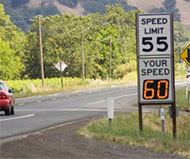4/14/2021
OPINION: How Speed Limits Are Set For Maximum ProfitCommentary on the current system the Federal Highway Administration uses to maximize the profitability of speed limits. Part 3 of a series

By John F. Carr
Before explaining the Federal Highway Administration's latest plan for more speed traps I will discuss their previous attempt, an "expert system" named USLIMITS2. USLIMITS2 is a tool used to set speed limits that is also a politically palatable program for a world accustomed to speed traps. The expression "garbage in, garbage out" is even older than the Federal Highway Administration. A computer will faithfully follow instructions no matter how nonsensical they are. But when a computer says something, many people take it seriously.
If you look at the experimental evidence there isn't much to put in a program. As the creators of USLIMITS2 said, "There is consensus that operating speed is a critical factor in determining an appropriate speed limit for a speed zone." This consensus is 75 years old and says that you shouldn't be criminalizing the average driver. One of those lies that is repeated so often people believe it is that this principle, the so-called "85th percentile rule," only applies to freeways. In fact, it was around before the interstate highway system was built.
They asked a panel of "persons engaged in setting, enforcing, or adjudicating speed limits" to review the program. Suppose the computer said the speed limit on a street should be 40 MPH. They asked a police officer, "Would you be willing to write tickets in a 40 zone?" They asked a traffic court judge, "Would you convict somebody of speeding in a 40 zone?" They asked a city councilor, "Would 40 MPH be acceptable to you?" They added common excuses for lowering speed limits until those representatives of the ticketing industry were happy. The experts then pushed back by saying a speed limit shouldn't be more than 10 MPH below what road safety would require. In most cases a speed limit that low is politically acceptable.
But there wasn't any evidence to justify the excuses for lowering speed limits. The leading studies on speed limit changes were by Martin Parker in the 1990s (view study in a 3mb PDF file). Parker found that changing numbers on signs had no effect on travel speed or safety of surface streets. In other words, lowering speed limits doesn't work. That is the only controlled before-and-after study cited in the report. Instead of evidence they appealed to the herd mentality. USLIMITS2 recommends low speed limits because people want speed limits to be lower.
The speeding ticket experts also also pulled a few numbers out of their hats. The speed limit on an Interstate must never be over 75 MPH. When the computer is put in charge Idaho, South Dakota, Texas, Utah and Wyoming will need to lower speed limits. Speed limits off freeways must never be higher than 65. Add Nebraska, North Dakota, and Oregon to the list of scofflaw states. If there is any roadside development, the speed limit must never be greater than 50. Add most of the rest of the country to the list.
Perhaps there is some value in having speed limits usually be wrong by the same amount. USLIMITS2 tends to recommend a speed limit 10 MPH too low. With the current patchwork of policies some limits are 5 MPH too low and others are 25 MPH too low. If the government mandated USLIMITS2, the old rule of thumb "it's OK to drive 10 over the speed limit" would finally have a factual basis. I don't think that's going to happen. If states were ordered to obey the computer those 25-too-low limits would have to be raised. Washington does not want to force safety on states or shut down speed traps. The proposal is to make USLIMITS2 optional. People who want to set speed limits 10 MPH too low will have an excuse: "the computer said so." People who want even lower speed limits will need to make up their own excuses. That is the subject of the next installment.
Part 1. The introduction to this series
Part 2. Proposed changes to stop sign rules
Read and comment on the proposed federal rule.


